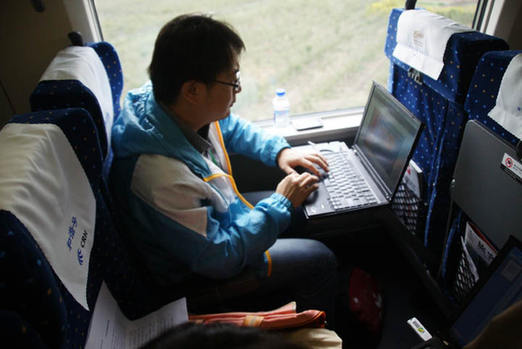| Haining and Hangzhou, Merging Communities
By special correspondent OUYANG LIANG
 |
|
Super-fast trains shorten not only travel time but the distance between a company and its market. Cnsphoto |
MA Yuejuan is very delighted by the opening of the Shanghai-Hangzhou High-speed Railway. Ma is the general manager of Hongda High Technology Holding Co., Ltd. in Haining, which is engaged in producing shell fabric for automobile interiors, sports clothes and military uniforms. Its customers include almost all the large-scale automobile companies in China like Shanghai Automotive Industry Corporation, Shanghai Volkswagen, Shanghai GM, FAW, Geely and Soueast.
“We have a very close connection with Shanghai, where many car companies are located, as well as famous international design firms and trade companies. About 90 percent of our products are sold in Shanghai and the neighboring market, or exported via Shanghai.” Hongda is located in Xucun Town, Haining City, Zhejiang Province, about 125 km west of Shanghai. “Commuters between Shanghai and the factory are plentiful,” Ma said. “Salespersons go to the city and back at least four times a week. Design company technicians and buyers from various trades in Shanghai also make trips to our factory very frequently.”
“It used to take about five hours to get from Xucun to Shanghai,” salesman Sun Jianhong recalled. “Before the high-speed railway opened, I needed to catch a slow train at 7:30 am and would arrive at 1 pm. On the expressway, if the traffic was OK, it was a two and a half hour drive.” The new line has shortened the time to 39 minutes. In the office, Sun is calling an agency to book a high-speed rail ticket while he jokes with colleagues about having lunch in downtown Shanghai.
The company is just a five-minute drive from Haining West Station, a high-speed rail stop. Ma Yuejuan thinks of the train as not only shortening the travel time but the distance between the company and its market. “It’s more convenient for staff, more importantly, for our customers, to come and go from Shanghai to our location. Customers used to just find a nearby factory, instead of traveling a hundred miles to a source. But now it’s even easier to get to us than to the suburb of Shanghai.”
Another advantage the high-speed rail brought to the company is a better competitive edge for attracting human resources, especially talent from Shanghai and Hangzhou, capital of Zhejiang. Some commute from Hangzhou. “But not enough,” Ma explains, “ I hope more people from Hangzhou will come to work here, and even from Shanghai, including those recruited for their overseas background.” Ma knows Xucun’s cultural and entertainment facilities cannot meet the demand of high-end talent, but the high-speed rail may make the small town more attractive for its accessibility to the big city.
Zhang Xuelin, deputy director of the Development and Reform Bureau of Haining, is confident about merging with Hangzhou’s market. In his opinion, it isn’t just the prospect of convenient transportation and closer connections between the two urban areas, but also the integration of administrative functions, economy and culture.
“It’s now a half hour’s drive from Xucun to Yuhang, a district under Hangzhou. In the next several years, it will be like two districts of a single city rather than two towns under two different cities.” Comprehensive planning of infrastructure construction will make sense, so Zhang Xuelin foresees further integration of the two places. Yuhang also has a high-speed railway station, which will be a complement rather than a competitor to Haining West Station.
“We need to give full play to Haining West Station functioning as a radiating hub,” Zhang said. Shen Linong, secretary of CPC Haining municipal committee, proposed a guiding principle: “developing Haining through servicing Hangzhou,” which will seal the bonds between them.
In 2007 Haining established the 180-sq-km Lianhang Economic Zone, encompassing Xucun Town, Chang’an Town, Agricultural Comprehensive Development Area, Linhang New District and Science and Education New City. “Hai-ning offers no airport but convenient transportation is provided by its railway station, expressway and waterway. In recent years, the logistics industry grew rapidly in the Lianhang Economic Zone,” Zhang said. “We plan to develop business, trade, and an exhibition industry that puts down deep roots in the Hangzhou economy.”
In fact, a modern and functional new city is emerging around Haining West Station, much as towns have followed rail lines throughout history. Over 90 companies, including Wahaha Chang-sheng Beverages Co., Ltd. and Xizi United Holding Corporation, have been introduced into the Agriculture Comprehensive Development Area. China Tyre City just opened and its tenants include the four largest tyre companies in China. Bailian Outlets set up a satellite – its first outside Shanghai – in Haining.
“The Bailian Outlets chose Haining because of transportation advantages, of course, and factored in high-speed rail. Its target customers are definitely not only Haining residents, but people from Hangzhou, Shaoxing and Ningbo,” says Zhang Xuelin.
|
